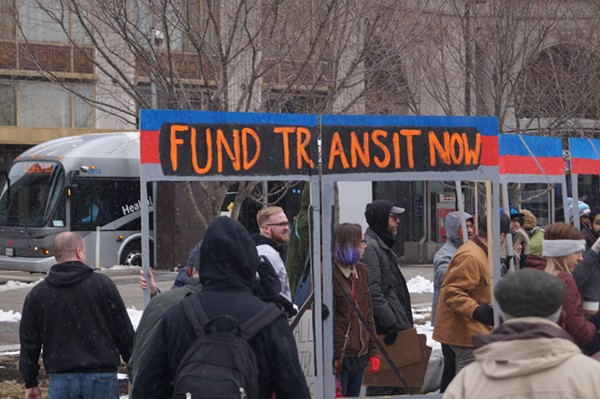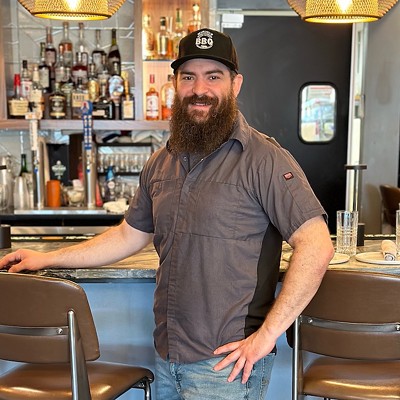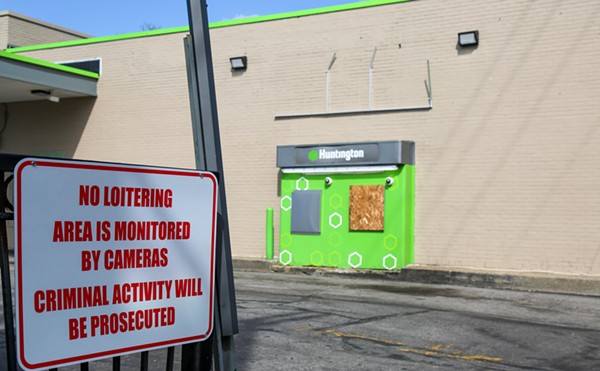RTA Can Improve Ridership or Improve Geographic Coverage. It Can't Do Both
By Sam Allard on Wed, Feb 20, 2019 at 10:16 am
[
{
"name": "Ad - NativeInline - Injected",
"component": "38482495",
"insertPoint": "3",
"requiredCountToDisplay": "5"
},{
"name": "Real 1 Player (r2) - Inline",
"component": "38482494",
"insertPoint": "2/3",
"requiredCountToDisplay": "9"
}
]
Transit consultant Jarrett Walker presented the outline for his RTA redesign study Tuesday afternoon, suggesting that his role was not to make recommendations for RTA's board of trustees and Cuyahoga County residents, but to help the region understand the system's problems more clearly.
As it turns out, there is one central problem: "RTA is spread really thin," Walker said. "It covers an enormous area... and, due to serious austerity, there's not much 'waste' left to cut."
Walker presented a map which showed that only 18 percent of Cuyahoga County residents live within half a mile of a high-frequency transit route, where a bus comes every 15 minutes or less.
Fares have increased. Routes have been slashed. And the system has hemorrhaged riders as a result. A system redesign has been sought specifically as an antidote to the ridership problem.
Walker, though, who has led successful studies in Houston, Columbus, Anchorage, Fresno, San Jose and elsewhere, said that his mission is not to increase ridership. Rather, he wants to present a set of clear options so that RTA can make an informed decision, fueled by public priorities, about how best to allocate its resources.
He and his team, after gathering feedback from a survey (which you can take here, anytime before March 17!) will work with local leaders and the public and will ultimately propose various ways to do that.
There are two directions RTA can go, Walker said: designing an alternative transit map to increase ridership (by increasing frequency along popular routes in dense, walkable areas); or designing a map to increase geographic coverage (by spreading even further out).
Like RTA, most transit agencies have hired Walker to increase ridership. Board member Rev. Charles Lucas said explicitly that ridership was the "bottom line" at Tuesday's meeting. Walker uses a percentage scale to represent a city's transit priorities (55% ridership / 45% coverage, say) and residents can voice their opinions about how they'd like the scale to shift.
Walker warned board members that once alternative maps are proposed, they are likely to generate controversy. People naturally are resistant to losing routes that they depend on. "My job is not to make this easy," he said. "My job is to make this clear."
He told reporters after the meeting that while he wouldn't be focused on long-term planning, RTA had a "sufficiently immediate" problem, "and I have no problem addressing the immediate problem immediately."
This problem — being spread too thin — Walker described as a "universal" in modern American cities, driven both by budgetary issues and historical patterns of suburbanization. Unlike other cities he has worked in, though — he cited both Houston and Auckland, New Zealand — Cleveland has made significant cuts already. "There's no obvious waste to trim," he said. So increasing ridership will necessarily come at the expense of other routes.
Clevelanders for Public Transit is aware of the difficult conversations ahead. But as it calls for additional reforms — the implementation of its Fair Fares proposals, notably — the transit advocacy organization has celebrated the potential of the study.
"If done well, the rewards are plentiful, resulting in faster trips to more destinations on transit and making transit a viable option instead of being forced to drive a car and sit in traffic," CPT said, "not to mention all the additional costs that come with car ownership — especially for those who can least afford to own, maintain, insure and finance a car."
Tags:
SCENE Supporters make it possible to tell the Cleveland stories you won’t find elsewhere.
Become a supporter today.
About The Author
Sam Allard
Sam Allard is the Senior Writer at Scene, in which capacity he covers politics and power and writes about movies when time permits. He's a graduate of the Medill School of Journalism at Northwestern University and the NEOMFA at Cleveland State. Prior to joining Scene, he was encamped in Sarajevo, Bosnia, on an...
Scroll to read more Cleveland News articles
Newsletters
Join Cleveland Scene Newsletters
Subscribe now to get the latest news delivered right to your inbox.















